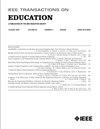PBL学生评估:计算机学院不同评估方法的一致性
IF 2
2区 工程技术
Q2 EDUCATION, SCIENTIFIC DISCIPLINES
引用次数: 0
摘要
贡献:本文分析了采用完整的基于项目的学习(PBL)方法的计算机学院的学生评估。该研究调查了60门课和60个学期的2078个期末成绩,揭示了自学成绩、考试成绩和项目成绩之间的显著相关性。这一结果有助于理解各种评估方法的可靠性和独立性,强调它们在PBL框架内衡量学生学习的有效性。背景:本研究的动机是需要在PBL环境下调查不同的学习评估方法,旨在建立背景并强调综合评估方法在计算机教育中的广泛适用性。预期结果:本研究旨在提供PBL框架内不同评估方法之间相互关系的信息。期望的结果是一个适用于不同班级和时期的全面理解,强调评估系统的稳健性。应用设计:在两年的时间里,在计算机学院实现一个完整的PBL模型,所选择的方法集成了分级自学、考试和项目,以确保一个全面的评估系统,捕捉学生对不同计算概念的熟练程度。这项研究涉及210名一年级和二年级学生,162名男性和48名女性,平均年龄为21.7±2.7岁。研究结果:对2078个期末成绩的相关分析表明,自修成绩、考试成绩和项目成绩之间的可靠性是一致的。这个结果强调了每个评估方法在PBL框架内衡量学习的有效性,突出了系统在计算教育环境中的健壮适用性。本文章由计算机程序翻译,如有差异,请以英文原文为准。
PBL Student Assessment: Consistency of Different Evaluation Methods in a Computing Faculty
Contribution: This article analyzes student assessment within a computing faculty employing a full project-based learning (PBL) approach. Examining 2078 final grades across 60 classes and periods, the study reveals a significant correlation between graded self-studies, exams, and projects. This result contributes to understanding the reliability and independence of diverse evaluation methods, emphasizing their effectiveness in measuring students’ learning within a PBL framework. Background: This study is motivated by the need to investigate diverse learning assessment methods within a PBL setting, aiming to establish context and underline the broad applicability of a comprehensive evaluation approach in computing education. Intended Outcomes: The study seeks to provide information about the interrelationships between different assessment methods within a PBL framework. The desired outcome is a comprehensive understanding applicable across various classes and periods, emphasizing the robustness of the assessment system. Application Design: Implementing a full PBL model in a computing faculty during a two-year period, the chosen approach integrates graded self-studies, exams, and projects to ensure a well-rounded evaluation system, capturing student proficiency across diverse computing concepts. This study involved 210 first- and second-year students, 162 men and 48 women, with a mean age of 21.7 ± 2.7 years. Findings: Correlation analysis of 2078 final grades indicates consistent reliability among graded self-studies, exams, and projects. This result underscores the effectiveness of each assessment method in measuring learning within a PBL framework, highlighting the system’s robust applicability in a computing educational environment.
求助全文
通过发布文献求助,成功后即可免费获取论文全文。
去求助
来源期刊

IEEE Transactions on Education
工程技术-工程:电子与电气
CiteScore
5.80
自引率
7.70%
发文量
90
审稿时长
1 months
期刊介绍:
The IEEE Transactions on Education (ToE) publishes significant and original scholarly contributions to education in electrical and electronics engineering, computer engineering, computer science, and other fields within the scope of interest of IEEE. Contributions must address discovery, integration, and/or application of knowledge in education in these fields. Articles must support contributions and assertions with compelling evidence and provide explicit, transparent descriptions of the processes through which the evidence is collected, analyzed, and interpreted. While characteristics of compelling evidence cannot be described to address every conceivable situation, generally assessment of the work being reported must go beyond student self-report and attitudinal data.
 求助内容:
求助内容: 应助结果提醒方式:
应助结果提醒方式:


